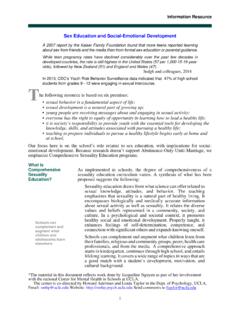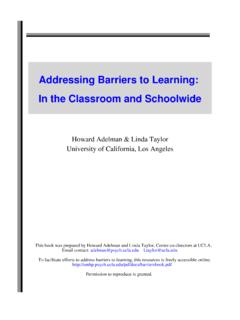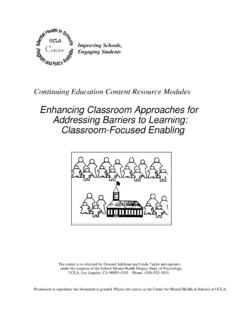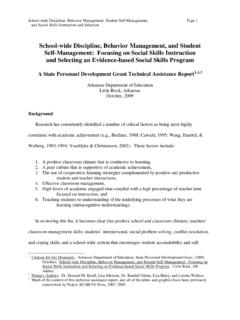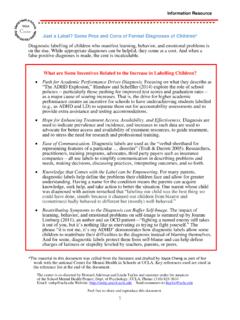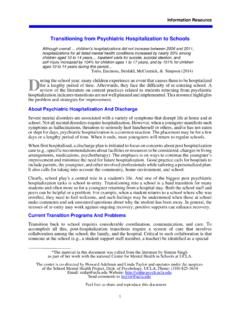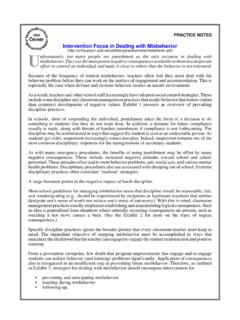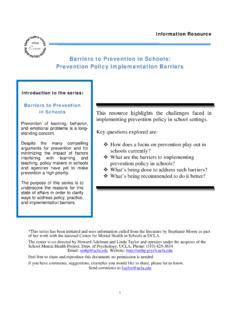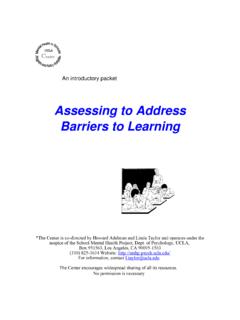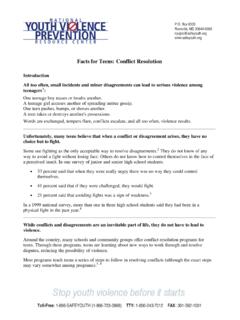Transcription of Affect and Mood Related to School Aged Youth
1 Introductory Packet Affect and Mood Related to School Aged Youth (Revised 2015)*The Center is co-directed by Howard Adelman and Linda Taylor and operates under the auspice of theSchool Mental Health Project, Dept. of Psychology, UCLA,Box 951563, Los Angeles, CA 90095-1563(310) 825-3634E-mail: .Permission to reproduce this document is cite source as the Center for Mental Health in Schools at UCLAA ffect and MoodOverviewPageIWhat Do We Mean When We Talk About Affect and Mood?..A. Defining Affect and Mood ..B. The Broad Continuum of Affect and Understanding the Causes of Problems Related to Affect and Mood ..A. Keeping the Environment in Perspective as a Cause of CommonlyIdentified Psychosocial Problems ..B. Environmental Situations and Potentially Stressful Eventsand Common Behavioral Overview of Protective and Risk Factors ..III Promoting Healthy Development and Preventing Mood and Affect Problems.
2 A. The Prevention of Mental Disorders in School -Aged Children:State of the Field ..B. Annotated Lists of Empirically Supported / Evidence Based Interventionsfor School -Aged Children and The Prevention of Depression in Youth ..D. About Positive Responding to the First Signs of Internalizing Disorders Overlooked in Loneliness in Young Depression in School : A Student s Trial ..D. Adolescent Depression: Helping Depressed Teens ..E. Children and Depression: Accommodations to Reduce Affect & Mood 1 2 5121316182122252829313233353640V Interventions for Serious Problems ..A. Depression1. Understanding the Problem ..2. Assessing the Problem ..3. Treating the Problem ..4. Suicide .. Regulation and Addictive Aspects of Repetitive Bipolar Disorder1. Child and Adolescent Bipolar Disorder ..2. Bipolar Disorder in Teens ..3. Sample Goals for Individualized Educational Program.
3 S Guide to Receiving Bipolar Students After Anger1. Controlling Anger .. Young Children Deal with Helping the Child Who is Expressing Anger ..4. Helping Your Children Navigate the Teen Years ..5. Model Programs ..VI References and References ..B. Agencies and Online Resources ..C. Center Resources .. 42 43 47 50 53 57 58 59 60 64 67 73 76 78 80 83 84 86 87 OverviewAffect and mood Related to School aged Youth covers a broad range of concerns. This Introductory Packet provides frameworks Related to Affect and mood for defining and describing, understanding causes ofproblems, Promoting health and positivedevelopment, Responding to the first signs ofproblems, interventions for seriousproblems. Resources are provided for more in depth and Mood Problems 1I. What Do We Mean When We Talk About Affect and Mood?A. Defining Affect and MoodB. The Broad Continuum of Affect and Mood2I.
4 What Do We Mean When We Talk About Affect and Mood?AA. Defining Affect and MoodAffectFrom: Gale Encyclopedia of Childhood and AdolescenceThe expressions of emotion or feelings to others include facial expressions, gestures, tone of voice, and othersigns of emotion such as laughter or tears. As a child grows and develops, environmental factors, such as peerpressure , and internal factors, such as self -consciousness, help to shape the is considered a normal range of Affect --display of emotion--varies from family to family, from situationto situation, and from culture to culture. Even within a culture, a wide variation in affective display can beconsidered normal. Certain individuals may gesture prolifically while talking, and display dramatic facialexpressions in reaction to social situations or other stimuli. Others may show little outward response to socialenvironments, expressing only a narrow range of Affect to the outside psychologists describe abnormalities in a child's Affect , they use specific terminology.
5 The normalaffect--which is different for each child and changes with each stage of childhood--is termed broad Affect , todescribe the range of expression of emotion that is considered typical. Persons with psychological disordersmay display variations in their Affect . A constricted Affect refers to a mild restriction in the range or intensity ofdisplay of feelings; as the display of emotion becomes more severely limited, the term blunted Affect may beapplied. The absence of any exhibition of emotions is described as flat Affect ; in this case, the voice ismonotone, the face is expressionless, and the body is immobile. Extreme variations in expressions of feelings istermed labile Affect . When the outward display of emotion is inappropriate for the situation, such as laughterwhile describing pain or sadness, the Affect is described as inappropriate. Labile Affect , also called lability, isused to describe emotional instability or dramatic mood : Gale Encyclopedia of PsychologyA mood, while relatively pervasive, is typically neither highly intense nor sustained over an extended period oftime.
6 Examples of mood include happiness, sadness, contemplativeness, and irritability. The definitions ofphrases to describe moods-such as good mood and bad mood-are imprecise. In addition, the range of whatis regarded as a normal or appropriate mood varies considerably from individual to individual and from cultureto ups and downs of adolescenceExcerpted from: Raising Children Network, with the Centre for Adolescent Did you know?Many people think that adolescence is always a difficult time, and that allteenagers experience bad moods and exhibit challenging behaviours. In fact, only5-15% of teenagers go through extreme emotional turmoil, become rebellious, orhave major conflicts with their and downs are a normal part of everyone s lives, teenagers included. Teenagers have alot going on physically, emotionally and socially which helps to explain why your childmight be having more moods than moods: what you need to knowSome days your child might be cheerful and excited, and other times he might seem down, flat,low or sad.
7 This is a normal part of life for young people in the same way it s normal for might notice your child feeling more ups and downs than she used to, or her moods mightbe more extreme. This could be for many reasons physical, emotional, social and psychological and not for any one reason in particular. Often you can t pin down the causes of adolescent upsand might also notice that your relationship with your child is changing, as well as how heshares her emotional world with you. Privacy might be very important to him. When your teenager wants more time on her own or more private headspace, it s notnecessarily that she s being moody it s actually a sign that your child is maturing andbecoming more independent. This can be a healthy part of adolescence, although your child stillneeds your supervision and changes in feelings, behaviour and thinking are normal and will last for longer thanmoods.
8 It s a time for you and your teenage child to learn new ways of communicating with eachother. Why the ups and downs?Physical factors Young people go through lots of physical changes during adolescence. They need to adjust totheir changing bodies, which might make them self -conscious or embarrassed or just makethem want more privacy and time to themselves. Children whose development seems to betaking a long time compared with friends might seem frustrated by or emotional about thesephysical physical factor is your child s need for sleep. It s thought that teenagers need more sleepthan they did when they were younger about 9 hours each night, in fact. So the amount ofsleep teenagers get is likely to Affect their , nutritious meals and enough physical activity are good for your child s physical healthand can help your child feel good emotionally factors Young people s brains keep developing into their early 20s.
9 The section of the brain that s thelast to develop, the prefrontal cortex, is closely connected to the areas responsible for regulatingand controlling emotions. This means young people can find it harder to keep a lid on some of their more powerful3emotions, and it might seem that they react more emotionally to situations than they used re also still learning to process and express those emotions in a grown-up and emotional factors New thoughts, new emotions, new friends and new responsibilities these all Affect how yourchild is child is learning how to solve more problems on his own as he moves towardsindependence. He s also living in his own head more than he used to, and is busy thinking aboutchallenges such as friendships, School and family relationships. Stressful family situations can impact on your child s mood the rest of this discussion and the links to Related resources, go to MOST TEEN MOOD SWINGS DECLINE WITH AGED ominique F.
10 Maciejewski et al. A 5-Year Longitudinal Study on Mood VariabilityAcross Adolescence Using Daily Diaries. Child Development, October 2015 Adolescence is typically regarded as a period of heightened emotionality, and an importanttime for Youth to learn to regulate their emotions. This longitudinal study looked at thedevelopment of teens' emotional stability. It found that mood swings gradually decline asteens age. Additionally, the study identifies when instability could require intervention. Allthis is seen as reassurance for parents concerned about their moody teens, while also helpingidentify when instability is considered risky and requires The Broad Continuum of Affect and What Do We Mean When We Talk About Affect and M ood?61. Developmental Variations: Behaviors within the Rangeof Expected Behaviors for That Age Group*DEVELOPMENTAL VARIATION COMMON DEVELOPMENTAL PRESENTATIONS Sadness VariationTransient depressive responses or moodchanges to stress are normal in otherwisehealthy populations.
